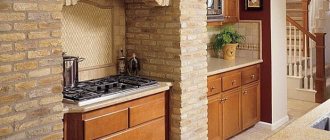Very often housewives want to have a spacious kitchen where they can create culinary masterpieces, receive guests at the dining table, etc.
Unfortunately, many apartments have narrow and small kitchens, while the bedrooms, on the contrary, are wide and large. Therefore, the issue of moving the kitchen into the living room is acute in many families.
Is it possible to move the kitchen to another place in the apartment, and if so, how to do it legally?
Moving the kitchen into the living room
The kitchen is the soul of the Russian home. This includes relatives, friends and neighbors. Household members gather here many times a day: they eat, communicate, exchange news, make plans, celebrate holidays, and celebrate significant dates. If the kitchen space can no longer accommodate those who want it, it becomes important to move the kitchen to the living room or a more suitable place. This article highlights the issues surrounding this difficult event. Content links will help you quickly find answers to the most pressing questions.
Content
- Relocating a kitchen from the point of view of current legislation
- Using the space of a dismantled bathroom
- Placing a kitchen in a living room
- Problems with sewerage, ventilation, lighting when moving the kitchen into an apartment
- The main obstacles to obtaining permission (legalizing the transfer)
- Conclusion
Registration process
You can begin to reorganize the space only after receiving approval from the relevant authorities.
If you start doing something without prior approval from the relevant authorities, problems may subsequently arise with the sale of your home .
But even without a sale, the Housing Inspectorate can check the condition of your home and, having discovered illegal reconstruction (the difference between before and after), or even worse, unacceptable changes, impose a substantial fine on you and the obligation to return the living space to its original appearance (COAP Article 7.21).
To avoid such troubles, it is necessary to agree . To do this, you must go through the following steps:
- Obtain a floor plan from the BTI, draw lines on it demonstrating the reconstruction, and submit it to the organization responsible for approving such changes.
- Write an application asking for permission to redevelop your living space.
- Order a project from a special organization.
- Coordinate the project with the necessary authorities.
- Submit your documents to the administration and obtain permission.
- Having received permission, carry out repairs in the apartment.
- Upon completion of the repair work, invite specialists to obtain a technical report and draw up a certificate of commissioning of the property.
- Contact the BTI to obtain a technical passport and floor plan.
- Draw up new title documents for the apartment in Rosreestr.
You can learn about whether it is necessary to legalize the redevelopment that has already been made in an apartment, as well as how to legalize the redevelopment yourself from the articles on our website.
Relocating a kitchen from the point of view of current legislation
Many of those wondering whether it is possible to move the kitchen into the living room are captured by erroneous judgments. Some believe that such a change in layout is impossible, others - that the path to obtaining permission to move the kitchen is littered with insurmountable problems, and others - that in your own privatized housing (apartment, house) any alterations are allowed, as long as there is enough space. Still others are convinced that they will be able to retroactively legitimize everything that is arbitrarily altered and transferred.
The result is numerous violations, refusals to legalize redevelopment and fines, damaged equipment, frayed nerves, shed tears, lost time and wasted funds. The above troubles can be avoided. To do this, you need to know and take into account the attitude of the legislation to changing the configuration of living space. Let us immediately note that the law allows for the redevelopment of an apartment with the relocation of the kitchen. The mandatory conditions are:
- Preservation (not deterioration) of your own living conditions and neighbors after moving the kitchen;
- Following current sanitary (SanPiN 2.1.2.2645-10) and construction (SNiP 31-03-2003) standards and regulations;
- Compliance with the procedure for obtaining permission for redevelopment and agreeing to move the kitchen to a room or another place;
- Legalization of unauthorized modification of the layout in accordance with the prescribed procedure.
To be fair, we note a number of legal reasons for moving a kitchen to a new location. Permitting procedures will be simplified as much as possible when:
- The apartment to be rebuilt is on the ground floor (no one’s living conditions and interests are affected, you can safely do the redevelopment, based on building regulations);
- The reconstruction was started by the owner or tenant of a two-level housing (the interests, sanitary and living conditions of the neighbors below are not affected);
- The kitchen area is “relocated” above the corridors, storage rooms, and other non-residential premises located on the lower floors.
During renovation work related to the placement of a kitchen space in another area, it is necessary to solve typical problems in linking the actions performed with the existing requirements of regulatory documents. These include:
- Use of space vacated as a result of demolition (liquidation) of a bathroom;
- Transfer of the kitchen itself and kitchen equipment to the living room;
- Modification of sewerage and water supply;
- Ensure proper ventilation and natural light.
We will lay out subsequent material in the same order.
Conclusion
But if the difficulties of re-equipment do not frighten you, and you are ready to pay due attention to cleaning, then you can begin moving the kitchen. In any case, you already know how to move the kitchen into the living room correctly!
Design of a kitchen-dining room in a private house - see here.
Did you like the article? Subscribe to our Yandex.Zen channel
Great article 0
Using the space of a dismantled bathroom
By law, it is prohibited to move a kitchen to the site of a bathroom or bathroom that was liquidated for this purpose. The provisions of SanPiN 2.1.2.2645-10 (clause 3.8) and SNiP 31-03-2003 (clause 9.22) prohibit placing bathrooms above living rooms and kitchen areas. The only exception is two-level apartments. According to the law, by placing a kitchen on the “territory” of a former toilet, the owners are formally worsening living conditions.
Just five years ago, the problem was solved by contacting the competent authority with a statement about the awareness of such a step and the obligation to notify the buyer about this in the event of an apartment sale. Today, this loophole in the law has been closed. Exceptions are housing on two levels or living on the top floor, excluding the presence of bathrooms for neighbors above.
What to do if the redevelopment has already been done?
Unauthorized actions can only be legalized through the courts. Moreover, new apartment owners who find out about the redevelopment after the purchase often have to do this.
If you discover unauthorized reconstruction of your home, you must:
- call a BTI engineer to record the true state of affairs and develop a new technical passport. The specialist will put a stamp on it about illegal redevelopment. The BTI engineer has the authority to inspect the supporting structures and issue a conclusion on their integrity if they were not affected during the reconstruction;
- submit an application to the Housing Inspectorate for approval of the changes, attaching documents received from the BTI employee. The commission’s refusal will serve as the basis for going to court.
After filing a claim, a commission will visit the apartment and evaluate it from the point of view of compliance with sanitary, construction and fire standards. If no reasons for refusal are found, the court will make a positive decision.
Placing a kitchen in a living room
On January 26, 2006, the Government of the Russian Federation, by resolution No. 47 (see paragraph 22), clearly prohibited the transfer of the kitchen to the place where their own premises were located or under which residential premises were located on the lower floors. Having arbitrarily carried out such a redevelopment, the developer formally changed the status of the neighbor’s room below to “non-residential”. Such a legal conflict is unacceptable. But the law does not prohibit moving kitchen equipment to the corridor, former storage room or other non-residential premises. Placing an apartment on the ground floor or above non-residential areas also does not create restrictions for the plan.
Another unpleasant moment. If the mentioned redevelopment is successful, it will not be possible to arrange a children’s room, living room or bedroom in the vacant (former “kitchen”) space. According to the law, living rooms cannot be located under the kitchens of neighbors above. However, this situation has a legal solution. This is the design of these square meters as a work office. Legally, it will be non-residential, but it can be used at the discretion of the owner.
A few more nuances to consider:
- The newly equipped kitchen should receive natural light through an existing window or through a glass partition from the adjacent room;
- When arranging a kitchen-living room (studio), you will need to replace the gas stove with an electric one;
- Reluctance to switch from gas to electricity will result in the impossibility of making an opening from the kitchen to the living room in the partition between the rooms or the need to install a closing door (sliding partition) in it;
- When deciding to replace a stove (gas to electric), it is advisable to evaluate the increase in electricity bills.
Redevelopment of fully electrified apartments is much easier than gasified ones!
Examples from judicial practice
Basically, the court adopts the Housing and Civil Codes, on the basis of which most cases end positively for the plaintiff:
- A citizen filed a lawsuit against the Administration. N. In 2014, he carried out the redevelopment without permission. He moved the kitchen into the hallway, combined the vacated space with part of the living room, turning the one-room apartment into a two-room apartment. The forensic expert was convinced that the regulatory requirements were not violated and the supporting structures were not affected. The court decided to keep the apartment in a redesigned state, that is, the claims of gr. N were satisfied.
- Gr. Kostina filed a lawsuit against the Smolensk Administration to preserve the apartment in a redesigned state. The essence of the plaintiff’s actions was to move the partitions between the kitchen and living room. Since the plumbing fixtures and stove remained in the same place, the court considered it possible to satisfy this claim.
At the moment, along with the Government Decree, the SNiP of 2003 has legal force, in which the ban on placement above living rooms applies only to bathrooms. The kitchen is not mentioned at all. The Supreme Court of the Russian Federation requires courts to take into account both documents equally.
Dear readers, the information in the article may be out of date, take advantage of a free consultation by calling: Moscow +7
, St. Petersburg
+7 (812) 425-62-38
, Regions
8800-350-97-52
Problems with sewerage, ventilation, lighting when moving the kitchen into an apartment
Now let’s look at what moving a kitchen means for house communications.
A gas stove is an obstacle to a radical change in layout. When starting a redevelopment, it is advisable to replace the gas stove with an electric one!
Sewerage and water supply
The normal functioning of the kitchen involves ensuring the supply (transfer) of all types of household communications to a new location. Building codes require that the water supply to the dishwasher and kitchen sink, as well as the disposal of used water, must be uninterrupted (unobstructed) and constant. To supply water, old cold and hot water supply pipes are extended (extended) or new ones are laid. Laying is carried out in four ways:
- Along the walls in fines;
- Under the screed;
- Under a suspended or suspended ceiling;
- In decorative wall boxes.
It is advisable to re-lay sewer pipes in old houses. This is more technologically advanced and makes it easy to eliminate the structural differences between cast iron and plastic pipes. In new buildings this problem is solved even easier. Laying under a screed, especially at a distance of more than 3-4 meters, is not possible without installing a special pump: in order for wastewater to drain naturally, it is necessary to ensure a pipe slope of 3-5 degrees (about 3 cm per 1 linear meter of sewerage).
Wiring
To ensure sufficient illumination of the working surface and dining area, the correct and safe functioning of kitchen household electrical appliances, electrical wiring should be carried out. It must match the power consumption.
Moving a kitchen without a well-thought-out wiring design (scheme), without a reasonable choice of the type, material and cross-section of current-carrying conductors is a dangerous undertaking. Improper wiring is the cause of most fires. Therefore, the design of the electrical wiring diagram and electrical installation work must be entrusted to qualified specialists. Unlike new buildings, when remodeling old houses, it is better to completely replace the electrical wiring rather than move it.
Ventilation
Those wondering “is it possible to move the kitchen?” must be aware that a new kitchen must be equipped with ventilation. In accordance with SNiP 31-3-2003 (clause 9.7), it is entrusted with the task of removing air with substances formed during the combustion of household gas. Ventilation:
- It is connected to the old (which existed before the apartment was renovated) sealed ventilation duct, which sometimes stretches through other rooms;
- It cannot intersect with the neighbors’ ventilation, nor with the one installed in the bathroom, nor connect to the latter.
The main obstacle to installing ventilation is hiding the duct. Ways to get around are suspended ceilings, decorative boxes, grooved walls (including load-bearing ones) with holes made in them. For the latter, you will need to obtain a permit. It is advisable to equip long ventilation ducts with exhaust fans. In older houses, it is sometimes necessary to clean the ventilation ducts. In new buildings there is no such problem.
Lighting
The newly equipped kitchen should have sufficient lighting. According to SNiP 05/23/2010, the lighting standard for a kitchen room is not less than 150 Lux. According to SaNPiN2.1.2.2645-10 and SP 54.13330.2016, natural light should enter it during the day. Possible paths:
- From the street through the existing window;
- Through a fiberglass door;
- From the adjacent room through a glass partition, a partition made of glass blocks.
If the kitchen is moved to one of the former residential premises, problems with wiring and natural lighting usually do not arise. The option of moving it to a non-residential premises may cause difficulties with lighting, which will not be difficult for the designers and architects of our Redevelopment Coordination Bureau “PereplanHome” to solve. At the end of the article, we will focus on barriers that can significantly complicate permitting procedures.
How to legitimize reconstruction?
What documents need to be completed to carry out a legal kitchen remodel?
The main rule: first we agree on the project and only after receiving permission we begin work. Moreover, obtaining permission is no less difficult than carrying out the work. The algorithm includes:
- collection of documents;
- sending the prepared package for consideration by the commission of architecture and urban planning under the municipality. You will have to be patient: 30 days are allotted for the examination of upcoming work, submitted papers and making a decision;
- hiring a team of specialists and carrying out work according to the reconstruction/redevelopment plan.
The main obstacles to obtaining permission (legalizing the transfer)
Those who have at least once tried to obtain permission to move a kitchen, or have legalized the redevelopment when it has already been moved, know firsthand about the existence of bureaucratic obstacles. To move a kitchen into a room or other premises legally, you need to remember the following or probable:
- Deterioration of living conditions;
- Violation of the integrity of load-bearing walls;
- Unqualified intervention in electrical wiring;
- Improper modification of the water supply system;
- Unacceptable changes to the heating system;
- Miscalculations in ensuring temperature conditions.
If the housing is located above administrative buildings (shop, office, cafe, restaurant), you do not need to worry that it will be prohibited from redevelopment, since in this case the kitchen will have to be moved above non-residential premises!
How much does it cost?
The price for kitchen remodeling consists of:
- project cost;
- state fees for changing entries in the register;
- costs for construction work.
Of the three components, only one is known - the state duty, which is 350 rubles. Other costs depend on the prices of the designer, builders and the scope of work. But in any case, all costs will result in more than tens of thousands of rubles.










